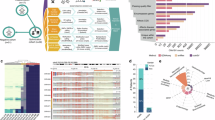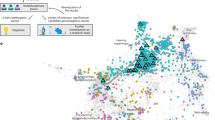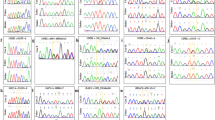Abstract
Neuronal intranuclear inclusion disease (NIID) is typically diagnosed through molecular techniques or skin biopsy, with GGC repeat expansions in NOTCH2NLC being a key molecular marker. This study investigated an NIID patient who had received skin biopsy confirmation but showed no detectable GGC repeat expansions in NOTCH2NLC through standard genetic testing. Using whole genome long-read sequencing (LRS), we identified GGC expansions in NOTCH2NLC along with three previously undetected upstream variants that had caused the initial false-negative molecular diagnosis. We further analyzed 501 essential tremor patients and 361 whole genome LRS datasets to characterize the region surrounding the GGC repeat expansion, revealing that these variants are rare. Our findings demonstrate that rare NOTCH2NLC variants can lead to false-negative molecular diagnoses in NIID patients, emphasizing the value of comprehensive genotyping through LRS. These results provide important guidance for developing diagnostic strategies for similar cases in the future.
This is a preview of subscription content, access via your institution
Access options
Subscribe to this journal
Receive 12 print issues and online access
269,00 € per year
only 22,42 € per issue
Buy this article
- Purchase on SpringerLink
- Instant access to full article PDF
Prices may be subject to local taxes which are calculated during checkout


Similar content being viewed by others
Data availability
The data supporting the findings of this study are available from the corresponding author upon reasonable request.
References
Wu W, Yu J, Qian X, Wang X, Xu Y, Wang Z, et al. Intermediate-length CGG repeat expansion in NOTCH2NLC is associated with pathologically confirmed Alzheimer’s disease. Neurobiol Aging. 2022;120:189–95.
Liao YC, Chang FP, Huang HW, Chen TB, Chou YT, Hsu SL, et al. GGC Repeat Expansion of NOTCH2NLC in Taiwanese Patients With Inherited Neuropathies. Neurology. 2022;98:e199–e206.
Yang D, Cen Z, Wang L, Chen X, Liu P, Wang H, et al. Neuronal intranuclear inclusion disease tremor-dominant subtype: A mimicker of essential tremor. Eur J Neurol. 2022;29:450–8.
Sone J, Hishikawa N, Koike H, Hattori N, Hirayama M, Nagamatsu M, et al. Neuronal intranuclear hyaline inclusion disease showing motor-sensory and autonomic neuropathy. Neurology. 2005;65:1538–43.
Liang H, Wang B, Li Q, Deng J, Wang L, Wang H, et al. Clinical and pathological features in adult-onset NIID patients with cortical enhancement. J Neurol. 2020;267:3187–98.
Sone J, Mitsuhashi S, Fujita A, Mizuguchi T, Hamanaka K, Mori K, et al. Long-read sequencing identifies GGC repeat expansions in NOTCH2NLC associated with neuronal intranuclear inclusion disease. Nat Genet. 2019;51:1215–21.
Itamoto S, Yanagi T, Yabe I, Matsuno Y, Ujiie H. Skin biopsies for diagnosing neuronal intranuclear inclusion disease: A retrospective study of 12 cases. J Dermatol. 2023;50:931–4.
Dolzhenko E, English A, Dashnow H, De Sena Brandine G, Mokveld T, Rowell WJ, et al. Characterization and visualization of tandem repeats at genome scale. Nat Biotechnol. 2024;42:1606–14.
Madeira F, Madhusoodanan N, Lee J, Eusebi A, Niewielska A, Tivey ARN, et al. The EMBL-EBI Job Dispatcher sequence analysis tools framework in 2024. Nucleic Acids Res. 2024;52:W521–W5.
Ishiura H, Shibata S, Yoshimura J, Suzuki Y, Qu W, Doi K, et al. Noncoding CGG repeat expansions in neuronal intranuclear inclusion disease, oculopharyngodistal myopathy and an overlapping disease. Nat Genet. 2019;51:1222–32.
Pellerin D, Del Gobbo GF, Couse M, Dolzhenko E, Nageshwaran SK, Cheung WA, et al. A common flanking variant is associated with enhanced stability of the FGF14-SCA27B repeat locus. Nat Genet. 2024;56:1366–70.
Tanudisastro HA, Deveson IW, Dashnow H, MacArthur DG. Sequencing and characterizing short tandem repeats in the human genome. Nat Rev Genet. 2024;25:460–75.
Sun QY, Xu Q, Tian Y, Hu ZM, Qin LX, Yang JX, et al. Expansion of GGC repeat in the human-specific NOTCH2NLC gene is associated with essential tremor. Brain. 2020;143:222–33.
Tian Y, Wang JL, Huang W, Zeng S, Jiao B, Liu Z, et al. Expansion of Human-Specific GGC Repeat in Neuronal Intranuclear Inclusion Disease-Related Disorders. Am J Hum Genet. 2019;105:166–76.
Zhang T, Bao L, Chen H. Review of Phenotypic Heterogeneity of Neuronal Intranuclear Inclusion Disease and NOTCH2NLC-Related GGC Repeat Expansion Disorders. Neurol Genet. 2024;10:e200132.
Acknowledgements
We express our sincere gratitude to all participants for their invaluable collaboration, as well as to the patients’ families for their understanding and assistance.
Funding
This study was supported by the Science and Technology Program of Zhejiang Province (2024C03100), the Zhejiang Provincial Natural Science Foundation of China (LQ24H090009), the Medical Science and Technology Project of Zhejiang Province (2024KY539), the National Natural Science Foundation of China (82450114) and the Zhejiang Provincial Natural Science Foundation of China (LY23H090010).
Author information
Authors and Affiliations
Contributions
Conceptualization and design: XZ, NJ, and WL; Methodology: XZ, NJ, and PL; Validation: DY and JL; Formal Analysis: NJ, DY, and LW; Investigation: XZ, NJ, and PL; Resources: XZ and NJ; Data Curation: DY, LW, YK, JL, and ZC; Writing – Original Draft Preparation: XZ, NJ, and PL; Writing – Review & Editing: XZ, NJ, PL, DY, LW, YK, JL, ZC, and WL; Visualization: PL and DY; Supervision: WL and XZ; Project Administration: WL and XZ; Funding Acquisition: WL.
Corresponding author
Ethics declarations
Competing interests
The authors declare no competing interests.
Ethical approval
All subjects provided written informed consent. The study received approval from the Ethics Committee of the Second Affiliated Hospital of Zhejiang University.
Additional information
Publisher’s note Springer Nature remains neutral with regard to jurisdictional claims in published maps and institutional affiliations.
Supplementary information
Rights and permissions
Springer Nature or its licensor (e.g. a society or other partner) holds exclusive rights to this article under a publishing agreement with the author(s) or other rightsholder(s); author self-archiving of the accepted manuscript version of this article is solely governed by the terms of such publishing agreement and applicable law.
About this article
Cite this article
Zheng, X., Jin, N., Liu, P. et al. Detection and characterization of rare variants in NOTCH2NLC causing false negative molecular diagnosis through long-read sequencing. Eur J Hum Genet (2025). https://doi.org/10.1038/s41431-025-01892-z
Received:
Revised:
Accepted:
Published:
DOI: https://doi.org/10.1038/s41431-025-01892-z



